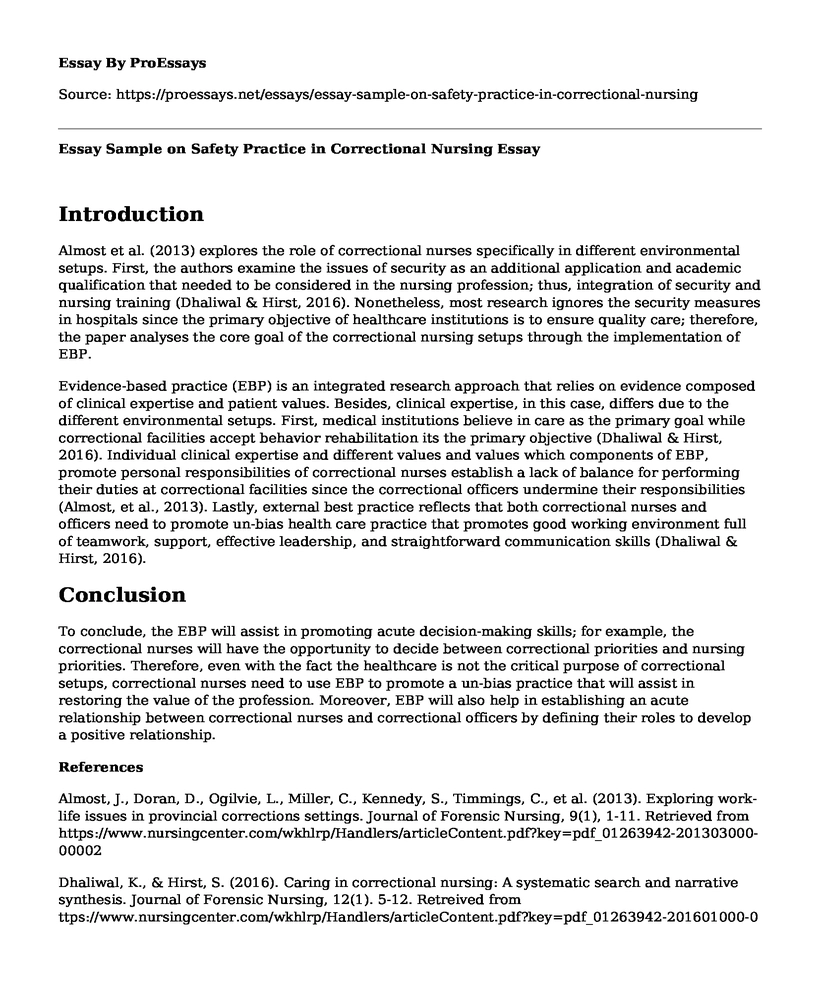Introduction
Almost et al. (2013) explores the role of correctional nurses specifically in different environmental setups. First, the authors examine the issues of security as an additional application and academic qualification that needed to be considered in the nursing profession; thus, integration of security and nursing training (Dhaliwal & Hirst, 2016). Nonetheless, most research ignores the security measures in hospitals since the primary objective of healthcare institutions is to ensure quality care; therefore, the paper analyses the core goal of the correctional nursing setups through the implementation of EBP.
Evidence-based practice (EBP) is an integrated research approach that relies on evidence composed of clinical expertise and patient values. Besides, clinical expertise, in this case, differs due to the different environmental setups. First, medical institutions believe in care as the primary goal while correctional facilities accept behavior rehabilitation its the primary objective (Dhaliwal & Hirst, 2016). Individual clinical expertise and different values and values which components of EBP, promote personal responsibilities of correctional nurses establish a lack of balance for performing their duties at correctional facilities since the correctional officers undermine their responsibilities (Almost, et al., 2013). Lastly, external best practice reflects that both correctional nurses and officers need to promote un-bias health care practice that promotes good working environment full of teamwork, support, effective leadership, and straightforward communication skills (Dhaliwal & Hirst, 2016).
Conclusion
To conclude, the EBP will assist in promoting acute decision-making skills; for example, the correctional nurses will have the opportunity to decide between correctional priorities and nursing priorities. Therefore, even with the fact the healthcare is not the critical purpose of correctional setups, correctional nurses need to use EBP to promote a un-bias practice that will assist in restoring the value of the profession. Moreover, EBP will also help in establishing an acute relationship between correctional nurses and correctional officers by defining their roles to develop a positive relationship.
References
Almost, J., Doran, D., Ogilvie, L., Miller, C., Kennedy, S., Timmings, C., et al. (2013). Exploring work-life issues in provincial corrections settings. Journal of Forensic Nursing, 9(1), 1-11. Retrieved from https://www.nursingcenter.com/wkhlrp/Handlers/articleContent.pdf?key=pdf_01263942-201303000-00002
Dhaliwal, K., & Hirst, S. (2016). Caring in correctional nursing: A systematic search and narrative synthesis. Journal of Forensic Nursing, 12(1). 5-12. Retreived from ttps://www.nursingcenter.com/wkhlrp/Handlers/articleContent.pdf?key=pdf_01263942-201601000-00002
Cite this page
Essay Sample on Safety Practice in Correctional Nursing. (2022, Dec 02). Retrieved from https://proessays.net/essays/essay-sample-on-safety-practice-in-correctional-nursing
If you are the original author of this essay and no longer wish to have it published on the ProEssays website, please click below to request its removal:
- Nursing Informatics Administrative Applications
- Literature Review Example on Teens' Awareness of Periodontitis and Oral Health
- An Analysis of the Indian Health Service Change
- Essay Example on Secondhand Smoke
- Paper Example on Analyzing Transmission Risks: Healthcare Workers and Portable Medical Equipment
- Jonathan Lee, Experienced DNP, APRN & Medical Director of Primary Care Practice - Report Example
- Paper Sample on ConnectiveRx: Enhancing Patient Support Through Mergers & Acquisitions







